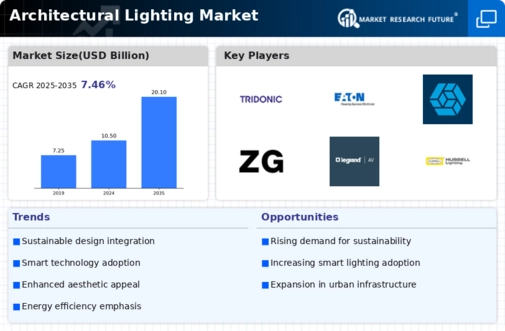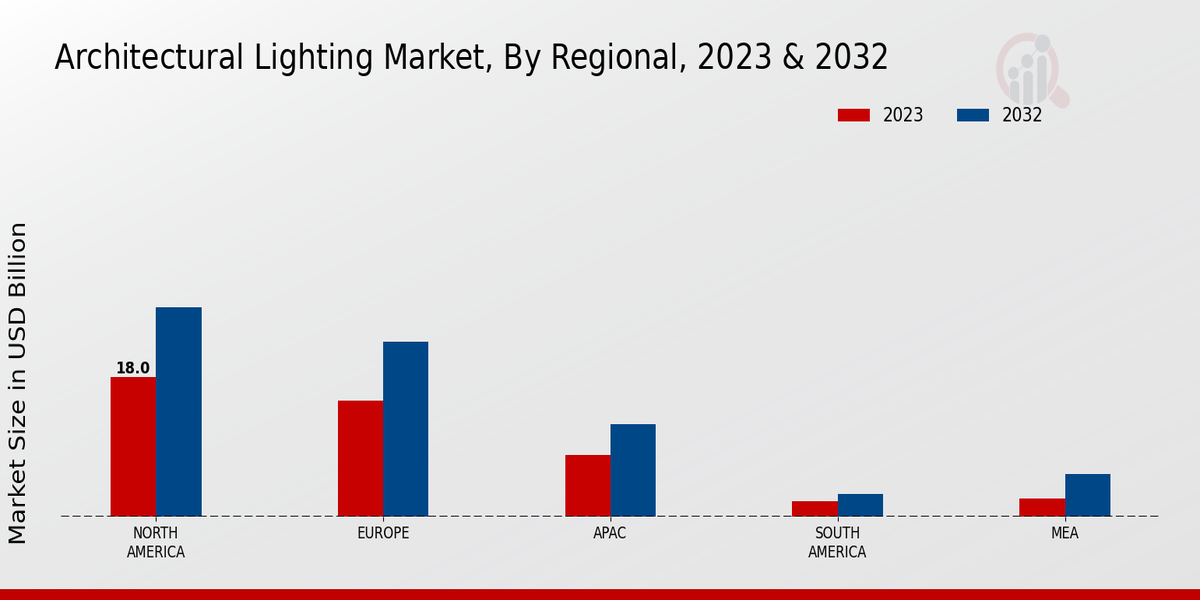Market Growth Projections
The Global Architectural Lighting Market Industry is projected to experience robust growth over the coming years. With a market value of 10.5 USD Billion in 2024, it is anticipated to reach 20.1 USD Billion by 2035, reflecting a compound annual growth rate (CAGR) of 6.08% from 2025 to 2035. This growth trajectory indicates a strong demand for innovative lighting solutions driven by factors such as urbanization, technological advancements, and a focus on energy efficiency. The market's expansion is likely to be supported by ongoing investments in infrastructure and the increasing integration of smart technologies in architectural lighting design.
Rising Demand for Energy Efficiency
The Global Architectural Lighting Market Industry experiences a notable surge in demand for energy-efficient lighting solutions. This trend is driven by increasing awareness of environmental sustainability and the need to reduce energy consumption. Governments worldwide are implementing stringent regulations aimed at promoting energy efficiency, which further propels the market. In 2024, the market is projected to reach 10.5 USD Billion, reflecting a growing preference for LED and smart lighting technologies. These innovations not only lower energy costs but also enhance the aesthetic appeal of architectural designs, making them increasingly popular among architects and designers.
Government Initiatives and Regulations
Government initiatives and regulations are instrumental in shaping the Global Architectural Lighting Market Industry. Many governments are promoting energy-efficient lighting solutions through incentives, subsidies, and regulatory frameworks. These initiatives aim to reduce carbon footprints and promote sustainable practices within the construction and design sectors. As a result, the market is poised for growth, with an expected valuation of 10.5 USD Billion in 2024. Such regulatory support encourages the adoption of advanced lighting technologies, fostering innovation and driving demand for architectural lighting solutions that meet stringent energy efficiency standards.
Focus on Aesthetic Appeal in Architecture
The emphasis on aesthetic appeal in architectural design significantly influences the Global Architectural Lighting Market Industry. Architects and designers are increasingly recognizing the importance of lighting in enhancing the visual impact of structures. This focus on aesthetics drives the demand for innovative lighting solutions that complement architectural styles and create immersive environments. As a result, the market is projected to grow at a CAGR of 6.08% from 2025 to 2035. This growth is indicative of a broader trend where lighting is not merely functional but is also considered an integral part of the overall design narrative, thereby enhancing the value of architectural projects.
Urbanization and Infrastructure Development
Urbanization and infrastructure development are critical drivers of the Global Architectural Lighting Market Industry. As cities expand and new infrastructures are built, the demand for innovative lighting solutions increases. Urban areas are increasingly adopting sophisticated lighting designs to enhance safety, aesthetics, and functionality in public spaces. This trend is particularly evident in developing regions, where rapid urban growth is occurring. The market's growth trajectory is supported by the anticipated increase in urban populations, which is expected to drive the market to 20.1 USD Billion by 2035. Consequently, urban planners and architects are prioritizing advanced lighting solutions in their designs.
Technological Advancements in Lighting Solutions
Technological advancements play a pivotal role in shaping the Global Architectural Lighting Market Industry. Innovations such as smart lighting systems, IoT integration, and advanced control mechanisms are transforming how lighting is designed and utilized in architectural spaces. These technologies allow for greater customization, energy savings, and improved user experiences. As a result, the market is expected to grow significantly, with projections indicating a rise to 20.1 USD Billion by 2035. The integration of technology in lighting design not only enhances functionality but also aligns with modern architectural trends, making it a key driver of market growth.














